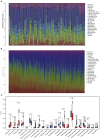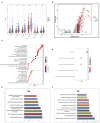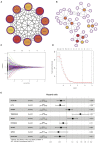A Novel Immune-Related Prognostic Model for Response to Immunotherapy and Survival in Patients With Lung Adenocarcinoma
- PMID: 33816503
- PMCID: PMC8017122
- DOI: 10.3389/fcell.2021.651406
A Novel Immune-Related Prognostic Model for Response to Immunotherapy and Survival in Patients With Lung Adenocarcinoma
Abstract
Lung adenocarcinoma is one of the most malignant diseases worldwide. The immune checkpoint inhibitors targeting programmed cell death protein 1 (PD-1) and programmed cell death-ligand 1 (PD-L1) have changed the paradigm of lung cancer treatment; however, there are still patients who are resistant. Further exploration of the immune infiltration status of lung adenocarcinoma (LUAD) is necessary for better clinical management. In our study, the CIBERSORT method was used to calculate the infiltration status of 22 immune cells in LUAD patients from The Cancer Genome Atlas (TCGA). We clustered LUAD based on immune infiltration status by consensus clustering. The differentially expressed genes (DEGs) between cold and hot tumor group were identified. Gene Ontology (GO) and Kyoto Encyclopedia of Genes and Genomes (KEGG) enrichment analysis were performed. Last, we constructed a Cox regression model. We found that the infiltration of M0 macrophage cells and follicular helper T cells predicted an unfavorable overall survival of patients. Consensus clustering of 22 immune cells identified 5 clusters with different patterns of immune cells infiltration, stromal cells infiltration, and tumor purity. Based on the immune scores, we classified these five clusters into hot and cold tumors, which are different in transcription profiles. Hot tumors are enriched in cytokine-cytokine receptor interaction, while cold tumors are enriched in metabolic pathways. Based on the hub genes and prognostic-related genes, we developed a Cox regression model to predict the overall survival of patients with LUAD and validated in other three datasets. In conclusion, we developed an immune-related signature that can predict the prognosis of patients, which might facilitate the clinical application of immunotherapy in LUAD.
Keywords: immune infiltration; immunotherapy; lung adenocarcinoma; prognosis; risk prediction model; signature.
Copyright © 2021 Zheng, Tian, Zhou, Xiao, Liu, Liu, Wang, Fan, Zheng, Tan, Xue, Gao, Li and He.
Conflict of interest statement
The authors declare that the research was conducted in the absence of any commercial or financial relationships that could be construed as a potential conflict of interest.
Figures








Similar articles
-
The prognostic value of immune escape-related genes in lung adenocarcinoma.Transl Cancer Res. 2024 Jun 30;13(6):2647-2661. doi: 10.21037/tcr-23-2295. Epub 2024 Jun 25. Transl Cancer Res. 2024. PMID: 38988926 Free PMC article.
-
Chromatin Separation Regulators Predict the Prognosis and Immune Microenvironment Estimation in Lung Adenocarcinoma.Front Genet. 2022 Jul 8;13:917150. doi: 10.3389/fgene.2022.917150. eCollection 2022. Front Genet. 2022. PMID: 35873497 Free PMC article.
-
A novel anoikis-related gene signature to predict the prognosis, immune infiltration, and therapeutic outcome of lung adenocarcinoma.J Thorac Dis. 2023 Mar 31;15(3):1335-1352. doi: 10.21037/jtd-23-149. J Thorac Dis. 2023. PMID: 37065587 Free PMC article.
-
Integrated analysis and validation reveal ACAP1 as a novel prognostic biomarker associated with tumor immunity in lung adenocarcinoma.Comput Struct Biotechnol J. 2022 Aug 13;20:4390-4401. doi: 10.1016/j.csbj.2022.08.026. eCollection 2022. Comput Struct Biotechnol J. 2022. PMID: 36051873 Free PMC article.
-
A signature-based classification of lung adenocarcinoma that stratifies tumor immunity.Front Oncol. 2023 Jan 12;12:1023833. doi: 10.3389/fonc.2022.1023833. eCollection 2022. Front Oncol. 2023. PMID: 36713530 Free PMC article.
Cited by
-
A novel LUAD prognosis prediction model based on immune checkpoint-related lncRNAs.Front Genet. 2022 Sep 21;13:1016449. doi: 10.3389/fgene.2022.1016449. eCollection 2022. Front Genet. 2022. PMID: 36212122 Free PMC article.
-
Immunotherapy for lung cancer combining the oligodeoxynucleotides of TLR9 agonist and TGF-β2 inhibitor.Cancer Immunol Immunother. 2023 May;72(5):1103-1120. doi: 10.1007/s00262-022-03315-0. Epub 2022 Nov 3. Cancer Immunol Immunother. 2023. PMID: 36326892 Free PMC article.
-
Genetic variants in the calcium signaling pathway participate in the pathogenesis of colorectal cancer through the tumor microenvironment.Front Oncol. 2023 Feb 7;13:992326. doi: 10.3389/fonc.2023.992326. eCollection 2023. Front Oncol. 2023. PMID: 36824126 Free PMC article.
-
Drug resistance related genes in lung adenocarcinoma predict patient prognosis and influence the tumor microenvironment.Sci Rep. 2023 Jun 15;13(1):9682. doi: 10.1038/s41598-023-35743-y. Sci Rep. 2023. PMID: 37322027 Free PMC article.
-
N7-methylguanosine-related lncRNAs: Predicting the prognosis and diagnosis of colorectal cancer in the cold and hot tumors.Front Genet. 2022 Jul 22;13:952836. doi: 10.3389/fgene.2022.952836. eCollection 2022. Front Genet. 2022. PMID: 35937987 Free PMC article.
References
LinkOut - more resources
Full Text Sources
Other Literature Sources
Research Materials

